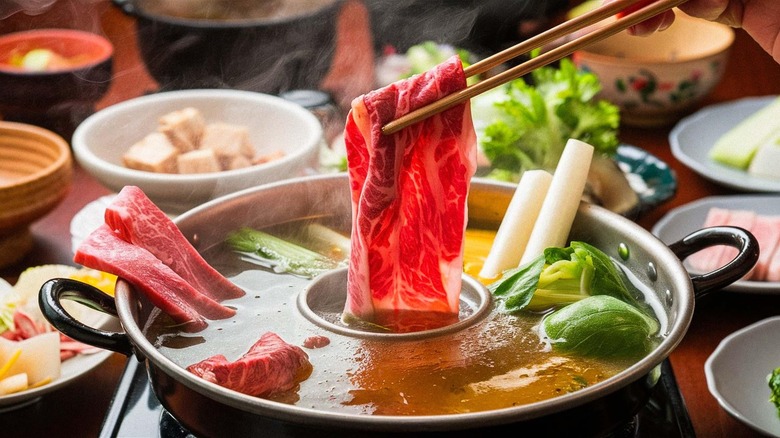The One Step To Never Skip For The Most Clear And Appetizing Hot Pot Broth
Nothing quite shouts out "dinner party!" like a hot pot. Mounds of thinly sliced meats, veggies, and aromatics await your guests, and once the broth is ready, everyone dives in with their chopsticks. Although there are conflicting theories about the origins of the hot pot, the communal eating experience is extraordinarily popular throughout East and Southeast Asia. There are aren't any hard and fast rules about what you dip into the broth, but the hot pot broth does need extra-special attention. Most recipes for hot pot have diners dunk thinly sliced raw meats or seafood into the broth, and as the meats cook, a gray foam rises to the surface and this scum clouds the broth, which happens with all meat-based soups. A common fix for cloudy broths is to stir in whipped egg whites and egg shells, which absorb the impurities. However, Kenny Yao, executive chef at YAO, who brings a modern approach to traditional Cantonese cooking, told us that there's a much easier method.
"Blanch the meat before stewing the broth," Yao explained, "it makes a huge difference." Blanching meat is easy to do, and even if it's not traditional, it's a step you should do with any hot pot. Starting with meat or bones in cold water, everything is brought to the boil, and as the scum rises, it's scooped out and discarded. The blanched meats won't exude foam, which, in turn, keeps the hot pot broth crystal clear and more appetizing.
Tips for making the best hot pot at home
Traditionally, a hot pot has two different broths: extra spicy and mild (for taking a break from the mouth-tingling heat). Northern Chinese hot pots focus on the meats with a lighter broth, while Southern Chinese hot pots are all about amping heat level with Sichuan chilis and the palate-vibrating Sichuan peppercorns.
To serve two different broths for your hot pot feast, you'll need two essentials for making a hot pot at home. Since the meal will be a communal gathering, you'll need an electric tabletop hot plate at the table to avoid continually heating up the broths on the stovetop. If you want to keep your hot pot to just one broth, then a stainless steel stock pot will do the trick, or for a more authentic serving, go with a dual-divided hot pot. Admittedly, making two broths for a hot pot can be quite time-consuming, but fortunately, there are a number of hot pot broth bases available that are a much-quicker and easier substitute.
Hot pots have lots of veggies, like sturdy greens, cabbage, and different types of mushrooms, and some kind of starch, like kabocha squash or russet potatoes. You'll find the meats — beef short ribs, chuck or brisket, pork belly — pre-sliced and often frozen at Asian markets, or you could ask your butcher to thinly slice the meats. But remember to follow Yao's tip to blanch the meats, and you'll have the best hot pot ever.

